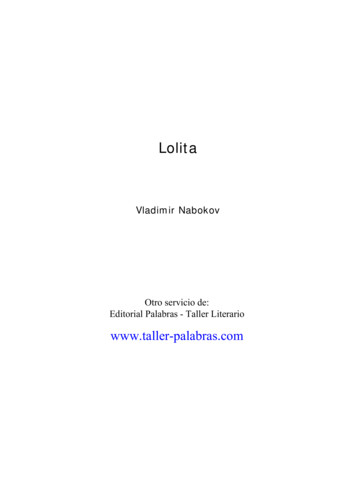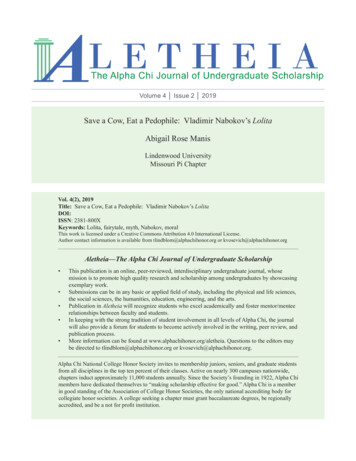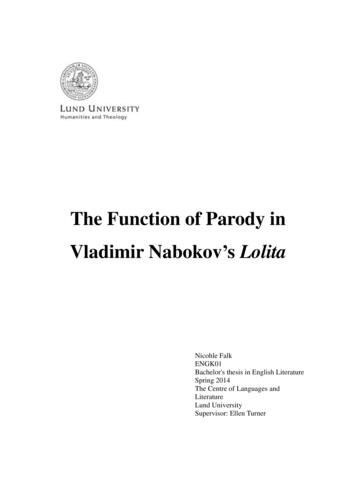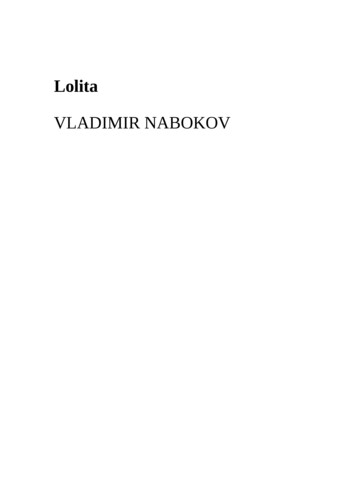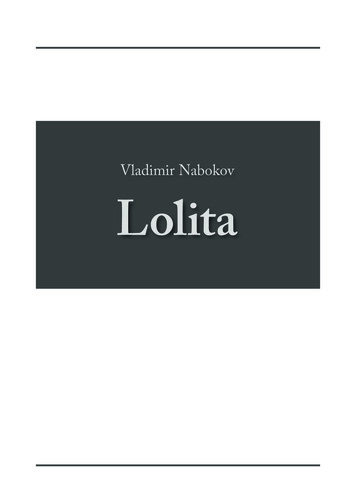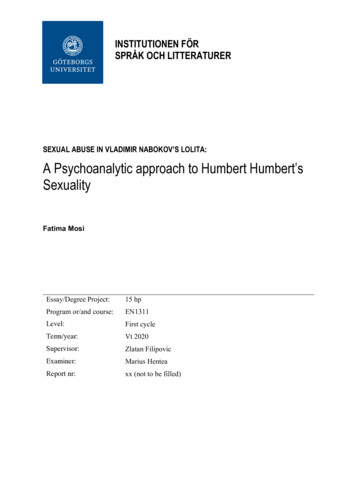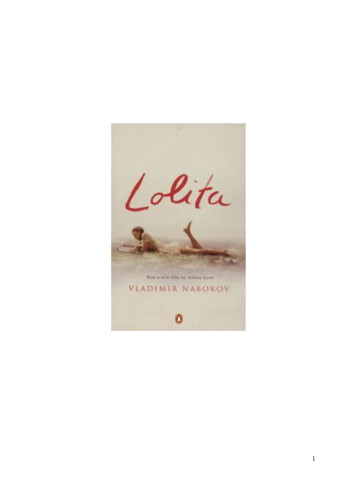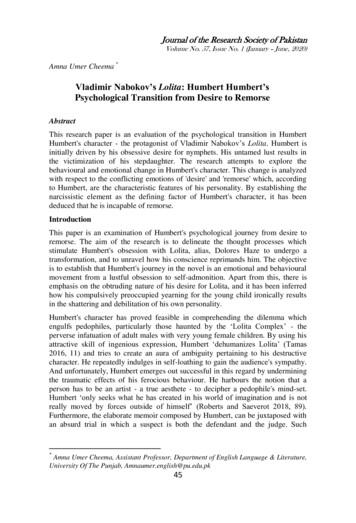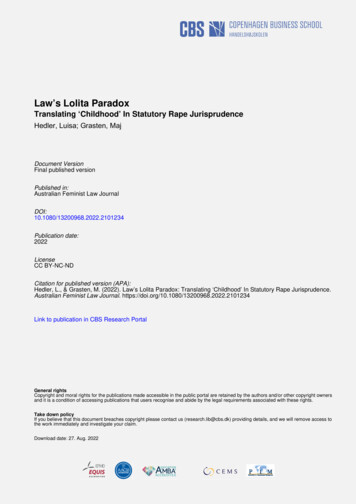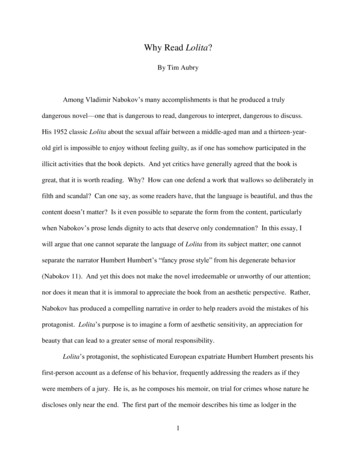
Transcription
Why Read Lolita?By Tim AubryAmong Vladimir Nabokov’s many accomplishments is that he produced a trulydangerous novel—one that is dangerous to read, dangerous to interpret, dangerous to discuss.His 1952 classic Lolita about the sexual affair between a middle-aged man and a thirteen-yearold girl is impossible to enjoy without feeling guilty, as if one has somehow participated in theillicit activities that the book depicts. And yet critics have generally agreed that the book isgreat, that it is worth reading. Why? How can one defend a work that wallows so deliberately infilth and scandal? Can one say, as some readers have, that the language is beautiful, and thus thecontent doesn’t matter? Is it even possible to separate the form from the content, particularlywhen Nabokov’s prose lends dignity to acts that deserve only condemnation? In this essay, Iwill argue that one cannot separate the language of Lolita from its subject matter; one cannotseparate the narrator Humbert Humbert’s “fancy prose style” from his degenerate behavior(Nabokov 11). And yet this does not make the novel irredeemable or unworthy of our attention;nor does it mean that it is immoral to appreciate the book from an aesthetic perspective. Rather,Nabokov has produced a compelling narrative in order to help readers avoid the mistakes of hisprotagonist. Lolita’s purpose is to imagine a form of aesthetic sensitivity, an appreciation forbeauty that can lead to a greater sense of moral responsibility.Lolita’s protagonist, the sophisticated European expatriate Humbert Humbert presents hisfirst-person account as a defense of his behavior, frequently addressing the readers as if theywere members of a jury. He is, as he composes his memoir, on trial for crimes whose nature hediscloses only near the end. The first part of the memoir describes his time as lodger in the1
suburban house of a vulgar American widow, Charlotte Haze, mother of the twelve-year-oldLolita. A self-declared “nympholept” (i.e. pedophile), Humbert goes to great lengths to getcloser to Lolita, even opting to marry her mother, which doesn’t allow him to consummate hisdesire until Charlotte dies in a freak car accident. Following this, Humbert becomes Lolita’sguardian and lover. He plays this role for several years, taking Lolita on two cross-country roadtrips, between which he enrolls her in a private high school, desperate to give their arrangementthe appearance of normalcy. Eventually Lolita is stolen from Humbert by a mysterious figure(another adult male predator), whom Humbert spends the latter part of the novel chasing with theaim of exacting murderous revenge. While Humbert’s claim that his narrative will exoneratehim is obviously meant to be ironic given the incriminating details he includes, he does prove tobe a remarkably charming, witty, and lyrical writer, and thus readers may in fact find themselvesseduced by him against their will. The question we are forced to ask, then, is to what purpose?What is there to be gained from getting to know and possibly even coming to like this morallyrepugnant character?One way of defending the novel is to underscore Humbert’s poetic power as a narrator.Consider the opening:Lolita, light of my life, fire of my loins. My sin, my soul. Lo-lee-ta: the tip of the tonguetaking a trip of three steps down the palate to tap, at three, on the teeth. Lo. Lee. Ta.She was Lo, plain Lo, in the morning, standing four feet ten in one sock. She wasLola in slacks. She was Dolly at school. She was Dolores on the dotted line. But in myarms she was always Lolita. (Nabokov 11)These sentences are packed with literary devices. There is alliteration, with the recurrence of “l,”“s,” and “t,” sounds making them a pleasure to pronounce. There is also incessant wordplay,with the variations on Lolita’s name signifying different parts of her personality and the “trip ofthree steps” describing the tongue’s movement, but also foreshadowing the three road trips that2
the novel will describe. Moreover, the narrator seems to be more attracted by Lolita’s name thanby her person, thus suggesting that the focus of the novel will be language and the pleasure it canproduce, rather than the adolescent girl with whom Humbert claims to be obsessed.In fact several critics, including Julia Bader, Steven Butler, and Howard Nemerov, havedefended the book by claiming that it is not really about pedophilia. In their view, Humbert’srelationship with Lolita is actually a metaphor for something else. According to Nemerov,“Lolita, if it is anything, ‘really,’ is the record of Nabokov’s love affair with the romantic novel”(321). Nemerov’s suggestion is that Humbert’s obsession is in fact a reflection and symbol ofNabokov’s obsession with certain literary forms. The author is not expressing an illicit desire; heis describing his obsession with language. Lolita is merely a vehicle for playing with words.Moreover, if we enjoy the novel, it is not because we as readers harbor secret pedophilicfantasies; we are simply appreciating the wordplay. This interpretation of the novel convenientlyoffers an alibi both to Nabokov and to his readers. It is a reminder that Lolita is merely a workof fiction, and nobody associated with it is guilty of anything.The problem with this interpretation is that it disregards the function that Humbert’sstylish prose performs. What it does is justify desires that we would otherwise view asreprehensible. Humbert describes the appeal of girls between the ages of nine and fourteen asfollows: “In fact, I would have the reader see ‘nine’ and ‘fourteen’ as the boundaries—themirrory beaches and rosy rocks—of an enchanted island haunted by those nymphets of mine andsurrounded by a vast, misty sea” (18). To Humbert, nymphets inhabit a kind of fairy-tale land,an escape from the ravages of time, and thus provide to older men a gateway to an idyllic,timeless state of being. Described this way, in deliberately romantic language, Humbert’s questto seduce an adolescent girl is presented as heroic, an idealistic attempt to defy the laws of time3
and space, to achieve a heightened state of perfection. Thus the language that critics have foundso appealing serves an immoral purpose: it makes Humbert’s creepy desire poetic and ultimatelymasks the grim reality: i.e. his vicious and self-serving rape of an innocent, powerless girl.According to several feminist critics, including Linda Kauffman and Colleen Kennedy,Nabokov’s language eclipses the suffering of Humbert’s victim, Lolita, turning her into asymbol, an allegorical figure, thus erasing her identity. In enjoying the language of Lolita , then,we as readers become complicit in Lolita’s suffering. Although Lolita is not a real person, ofcourse, in celebrating Nabokov’s novel, we are supporting the kind of rhetoric that has served inthe real world to turn men, however objectionable their actions, into heroic figures, whileeffacing the yearnings, hopes, and suffering of the women they harm. If such arguments arecorrect, Lolita is an indefensibly misogynistic book.Other critics, including Michael Wood, Leland de la Durantaye, and Nomi Tamir-Ghez,argue that while the narrator, Humbert, is a horrible person, the novel recognizes this fact andthus presents his story in order to prevent readers from behaving in a similar fashion.Significantly, Lolita offers a moral even to those readers who do not share Humbert’sparticularly perversity. The bigger problem with Humbert is that he is a pure aesthete. Thismeans he pursues beauty above all else and places aesthetic satisfaction above the needs ofeveryone around him. What Lolita offers, then, is a dramatization of the dangers ofaestheticism—of the way that seeking private aesthetic satisfaction can lead one to be insensitiveto the needs of others. Richard Rorty is the critic who has made this argument mostpersuasively. He remarks: “Nabokov wrote about cruelty from the inside, helping us to see theway in which the private pursuit of aesthetic bliss produces cruelty” (Rorty 146). Moreover, thebook aims to help readers catch themselves viewing the world in the same way that Humbert4
does and correct their own mistaken perspective. “The reader suddenly revealed to himself as, ifnot hypocritical, at least cruelly incurious, recognizes his sembable, his brother, in Humbert.”(163).The central problem with Humbert, according to Rorty is that he is incurious; he noticespeople and things in the world only if they support his own peculiar obsessions. He treats Lolitanot as a person, but as mythic creature, thus superimposing a fiction that he has created onto her.Another word for his way of perceiving things is “solipsism”: the belief that you are the onlyperson in the world and everyone else is just a figment of your imagination. While Rorty noticesa couple key instances of this solipsism, we can find evidence of it on almost every page. Indescribing a drive during the night, for instance, Humbert writes, “By that time night hadeliminated most of the landscape and as I followed the narrow winding highway, a series of shortposts, ghostly white, with reflectors, borrowed my own lights to indicate this or that curve”(294). The telling word in this sentence is “eliminated.” What Humbert suggests here is thatwhen he cannot see the landscape, it actually ceases to exist. His subjective perceptionsconstitute the only world that he cares about. Such mundane examples are important becausethey reveal a resemblance between Humbert’s obviously pathological tendencies and the moreeveryday narcissism to which many of us are prone. Don’t we all at times think of ourselves aspositioned at the center of the universe? Don’t we forget to wonder what our friends and familymembers of thinking about, worrying about, when they are not in the room with us? The goal ofLolita, in other words, may be to remind us that we are not all that different from the sinisterHumbert, and to teach us to become better.If Lolita has helped readers avoid the pitfalls of narcissism, then one would have toconclude that the novel is worth reading. The problem with this argument, however, is that it5
equates aestheticism with evil. Humbert’s love of literature has led him to view the worldaround him as if it were a work of art, with him at the center, and thus everyone else is merely asymbol reflecting his own thoughts and feelings. In constructing this imaginary world, hedisregards the emotions of those closest to him, inflicting pain on them whenever necessary.Moreover, he rationalizes his cruelty through the use of poetic language. If Humbert is anexample of how not to lead one’s life, then the novel seems to be a condemnation of aestheticsatisfaction, a reminder of how the appreciation of beauty and the attraction to poetic languagecan make us selfish, if not solipsistic. But this interpretation leads to a strange paradox. It wouldmean that Nabokov has written a beautifully poetic novel in order to represent the evil thatappreciating such poetry can entail. Are we supposed to enjoy Lolita only so that we can rejectsuch enjoyment? To put it another way, does Lolita offer any way of cultivating aestheticpleasure, of appreciating poetry and beauty, without thereby becoming selfish, narcissistic, andcruel?Several scholars, including Julia Bader, Leland de la Durantaye, and Alfred Appel Jr.have argued that Lolita suggests the possibility of a virtuous form of aesthetic bliss, focusing onthe way that Nabokov defines the term in his afterword to the novel. There Nabokov declares,“For me a work of fiction exists only insofar as it affords me what I shall bluntly call aestheticbliss, that is a sense of being somehow, somewhere connected with other states of being whereart (curiosity, tenderness, kindness, ecstasy) is the norm.” (Nabokov 316-317). Surprisingly,aesthetic bliss includes “curiosity, tenderness, kindness”—all of which would suggest a concernfor the feelings of others. This makes a certain amount of sense. When we have a powerfulemotional response to a work of art, though this response may involve private bliss, it alsofrequently depends upon a feeling of sympathy for the characters that we read about, an ability to6
see the world from their point of view. Isn’t it possible that enjoying works of art, appreciatingthe poetic language used to describe the experiences of fictional characters, allows us to confrontothers in the world with greater understanding and compassion? To do so, of course, wouldmean viewing both art and life in a way that is antithetical to Humbert’s own perspective. At onepoint, he describes his masturbatory fantasy about Lolita as “a state of absolute serenity,confidence, and reliance” (Nabokov 62). Humbert’s aesthetic pleasure is entirely self-contained,based on a fantasy that isolates him from the world of other people. Significantly, Nabokovdefines aesthetic bliss in opposition to Humbert’s conception, thus suggesting that Lolita isdesigned to underscore the limitations of the narrator’s point of view, and to argue for a kind ofaesthetic pleasure that can lead to greater kindness and sensitivity.Nabokov’s afterword raises an important question. Does the novel itself feature anymoments in which aesthetic bliss produces curiosity, tenderness, or kindness? Does Humbert’slyrical narrative ever describe or elicit such feelings? According to Sean Benson, Humbertexperiences a moral epiphany near the end of the novel and thus escapes his own narcissism(Benson 360). He realizes that he has deprived Lolita of her childhood and eventually comes toview her with the tenderness that true aesthetic appreciation requires.The scene that would seem to bear out Benson’s conclusion is the one in which Humbertis briefly reunited with Lolita years after she escape him. Remarkably, although Lolita is nolonger between the ages of nine and fourteen, Humbert still feels entranced by her. He observes:There she was with her ruined looks and her adult, rope-veined narrow hands and hergoose-flesh white arms, and her shallow ears, and her unkempt armpits, there she was(my Lolita!), hopelessly worn out at seventeen, with that baby, dreaming already in her ofbecoming a big shot and retiring around 2020 A.D.—and I looked and looked at her, andknew as clearly as I know I am to die, that I loved her more than anything that I had everseen or imagined on earth, or hoped for anywhere else . You may jeer at me, andthreaten to clear the court, but until I am gagged and half-throttled, I will shout my poortruth. I insist the world know how much I loved my Lolita, this Lolita, pale and polluted,7
and big with another’s child, but still gray-eyed, still sooty-lashed, still auburn andalmond, still Carmencita, still mine (Lolita 279-280).Here Humbert appears to see Lolita as she really is, without projecting any perverse fantasiesonto her, without turning her into a symbol within his own private mythology. He notices her“rope-veined narrow hands” and her “unkempt armpits.” Perhaps even more importantly, he notonly sees her, but loves her, finds her beautiful even with her imperfections. Here he seems hereto use poetry in the way that both Wordsworth and George Eliot imagined it might be used: tomake the average ugly people around us beautiful, so that we can view them with greater warmthand affection. Through its careful description and its subtle pathos—capturing what Humbertmust now forever relinquish in part because he could never appreciate it when he was in itspresence—the passage appears to be demonstrating a way of perceiving, a way of describingothers, that can unite aesthetic bliss and moral responsibility.That said, readers might wonder whether Humbert has truly made progress. Throughoutthis scene, he continues to refer to her as “my” Lolita thus betraying the possessiveness that hasdehumanized her throughout the text. Indeed, given that “my Lolita” is the final phrase of thebook, it seems unlikely that Humbert will ever escape this way of regarding her. Moreover, hecontinues to employ a vocabulary that idealizes youth and scorns age, noting Lolita’s “ruinedlooks,” finding her to be “polluted” because she is pregnant, and most absurdly of all,characterizing her as “worn out,” although she is only seventeen. Thus Humbert, even in thismoment of apparent tenderness, is still the same pedophile he has been throughout the book. It isalso worth noting that he is explicitly addressing his readers and in this case subtlyacknowledging that he is trying to manipulate us by making us see him as not quite the monsterhe has appeared to be throughout the novel. But the Humbert who describes this moment ofregret and vulnerability is the same one who catalogues the bodily charms of the adolescent8
Lolita with a self-indulgently cavalier attitude, an attitude that paints those who would judge himas hopelessly naïve and conventional, while presenting himself as the dashing romantic genius.It may not matter, however, whether Humbert truly becomes a better person by the end ofthe book. Even if Humbert continues until the final pages to be the same vicious, solipsisticpedophile whom we encounter at the outset, this does not mean that the novel is itself evil. Whatmakes Lolita valuable is that it shows how a commitment to aesthetic bliss can lead toselfishness and cruelty, while gesturing toward a different kind of aesthetic bliss, one that can, incertain circumstances, have the opposite effect. To be clear, Humbert only approaches but neverfully realizes this second kind of aesthetic bliss. At certain times, in other words, he seems toescape the shell of his own mind, to see Lolita Haze as she exists, lives, and feels beyond thehaze of his own consciousness. But these moments are short-lived, qualified by his knee-jerkcynicism, complicated in his mind and the minds of his readers by the fear that he is merelytrying to seem good, and rapidly engulfed by the narcissistic fantasies that simmer at all timeswithin his mind, waiting to consume all foreign entities. Nabokov, however, is not the same asHumbert, and he clearly strives to imagine a form of art that can connect minds and bring us intocontact with “other states of being.” Moreover, the reason Humbert’s moments of sensitivity areso rare is not just that he is a horrible person; Nabokov may also be suggesting how difficult it isfor anyone to achieve such moments—how similar we all are to Humbert. Indeed to escapenarcissism may require a certain kind of extraordinary poetry, the poetry that Humbert andNabokov manage to produce only in a handful of moments in the book.Describing his first road trip with Lolita, Humbert observes:And so we rolled East. I more devastated than braced with the satisfaction of mypassion, and she glowing with health, her bi-iliac garland still as brief as a lad’s, althoughshe had added two inches to her statue and eight pounds to her weight. We had beeneverywhere. We had really seen nothing. And I catch myself thinking today that our long9
journey had only defiled with a sinuous trail of slime the lovely, trustful, dreamy, enormouscountry that by then, in retrospect, was no more to us than a collection of dog-eared maps,ruined tour books, old tires, and her sobs in the night, every night—the moment I feignedsleep. (177-178)Here Humbert is surprisingly honest. Ordinarily intent on underscoring his supernatural powersof observation, he seems in this moment to recognize how he has failed to see the people andplaces around him. However thoroughly he and Lolita explored America, they did not grasp it.Their premeditated ideas, stolen from tour books, obscured their vision of what was actually inthe country they travelled through. He imagines Lolita “glowing with health” a glow that blindshim to her misery and desperation. And Lolita too fails to recognize that Humbert is onlypretending to sleep in the motel rooms where they briefly reside. And yet the passage seems tosuggest the possibility of getting around the various barriers to our vision, of getting at leastindirect access to those realities we cannot face head on. Humbert makes Lolita a partner in hisviolation of America, and yet his language subtly suggests that he has placed her in the wrongposition: she is not the defiler, but the defiled, and thus his personification of America registershis oblique, never consciously acknowledged perception of her as “trustful, dreamy, andenormous”—a person with her own hopes and fantasies, with vast interior worlds that he hasirreversibly contaminated. Within our moments of blindness, Nabokov suggests, there are clueswe can discover as to what exists beyond our own minds, assuming we are sensitive to the poetryaround us, the poetry that tends to hide in plain sight. It is worth nothing that even in the dark,where he can apparently see nothing, Humbert can still hear Lolita’s sobs.10
Works CitedAppel, Alfred Jr. “The Springboard of Parody.” Wisconsin Journal of Contemporary Literature 8(1967): 204-241.Bader, Julia. Crystal Land: Artifice in Nabokov’s English Novels. Berkeley: University ofCalifornia P, 1972.Benson, Sean. “Augustinian Evil and Moral Good in Lolita.” Renascence: Essays on Values inLiterature 64 (2012): 353-367.Butler, Steven H. “Lolita and the Modern Experience of Beauty.” Studies in the Novel 18 (1986):427-437.De la Durantaye, Leland. Style is Matter: The Moral Art of Vladimir Nabokov. Ithaca: CornellUP, 2007.Eliot, George. Adam Bede. New York: Penguin, 1980.Kaufman, Linda. “Framing Lolita: Is There a Woman in the Text?” Eds. Patricia Yaeger, BethKowaleski-Wallace, and Nancy K. Miller, Refiguring the Father: New Feminist Readingsof Patriarchy. Carbondale, IL: Southern Illinois UP, 1989, 131-52.Kennedy, Colleen. “The White Man’s Guest, or Why Aren’t More Feminists Rereading Lolita.”Eds. Janice Carlisle and Daniel R. Schwarz, Narrative and Culture. Athens: U of GeorgiaP, 1994, 46-57.Nabokov, Vladimir. Lolita. New York: G.P. Putnam’s Sons, 1955.Nemerov, Howard. “Review of Lolita.” The Kenyon Review 19 (1957): 313-314; 316-321.Rorty, Richard. Contingency, Irony, and Solidarity. Cambridge: Cambridge UP, 1989.Tamir-Ghez, Nomi. “The Art of Persuasion in Nabokov's Lolita.” Poetics Today 1 (1979): 6583.Wood, Michael. “Lolita Revisited.” New England Review: Middlebury Series 17 (1995): 15-43.Wordsworth, William. “Preface to the Second Edition of Lyrical Ballads.” Critical Theory SincePlato, Revised Edition. Ed. Hazard Adams. New York: Harcourt, 1992. 436-446.11
Why Read Lolita? By Tim Aubry Among Vladimir Nabokov's many accomplishments is that he produced a truly dangerous novel—one that is dangerous to read, dangerous to interpret, dangerous to discuss. His 1952 classic Lolita about the sexual affair between a middle-aged man and a thirteen-year-
